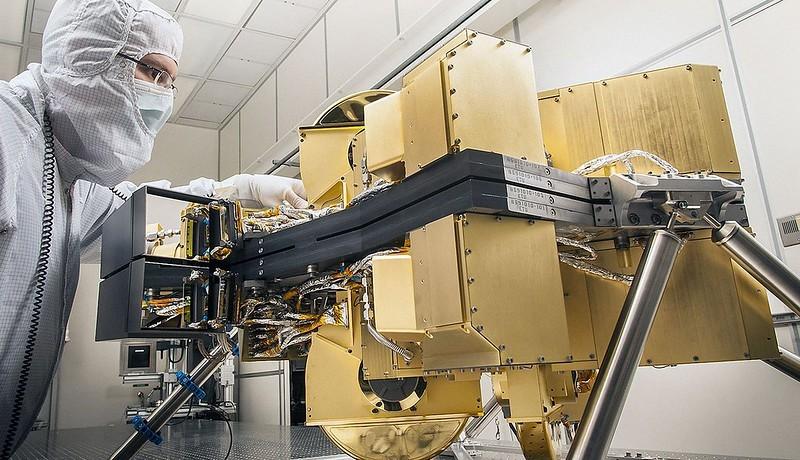Every innovation made in the astronomy field makes the “great unknown” that is space a little less unknown, and NASA’s James Webb Telescope should answer even more questions about the far reaches of the universe.
Marcia Rieke, University of Arizona regents’ professor at the Steward Observatory, and her team developed the Near Infrared Camera. With this development, NASA’s James Webb Telescope will be able to take images clearer and farther into unexplored galaxies across the universe.
Kevin Hainline, an assistant research professor at the Steward Observatory, worked on the near campus science team under Rieke. According to Hainline, when starting this project, about 30 years ago, NASA asked a variety of institutions to put in proposals if they wanted to help build different aspects of the James Webb Telescope. Rieke put in a proposal on behalf of the UA to build an instrument that could analyze a wide range of infrared light, which eventually became the NIRCam. In exchange for building a part of the James Webb Telescope, NASA awarded Rieke and her team 900 hours of time to orient the James Webb Telescope and collect data.
Hainline has been working at the Steward Observatory, where the NIRCam was created, but after the James Webb Telescope launches on Dec. 18, he will be working at the Space Telescope Science Institute. There, he will be a part of the team who monitors the NIRCam as it operates on the James Webb telescope.
RELATED: Q&A with Dr. Nathan Price: COVID-19 vaccinations and disease in children and adolescents
To expand on what the James Webb Telescope is meant to accomplish in its exploration of space and why so many UA faculty have devoted their time to creating NIRCam, the Daily Wildcat spoke with professor Hainline.
Daily Wildcat: Isn’t the James Webb Telescope one of the biggest space observatories launched since the Hubble in 1990?
Kevin Hainline: “We’ve sent up many space observatories since 1990. I can name a bunch. But the thing is that these ones have had very specific purposes. And they haven’t really captured the public imagination like Hubble did. Hubble was like a world changing space observatory… There’s a telescope called Spitzer named after an astronomer named Lyman Spitzer. Many of the instruments [on Spitzer] were built by the people who are building NIRCam, and because it’s an infrared telescope, the James Webb Telescope is kind of a bigger sibling of Spitzer… We built the James Webb Telescope, not just to be the successor to Hubble, but also to build off of what we’ve done with the Spitzer Space Telescope.”
DW: What will NIRCam do while operating on the James Webb Telescope?
KH: “NIRCam is called NIRCam because it is a Near Infrared camera. Infrared is the light that is just outside of what we can see with our eyes to a little bit longer wavelengths…which means that our eyes could not see what the James Webb Telescope [will] pick up.”
DW: How far will the James Webb Telescope orbit around earth?
KH: “1 million miles away, well beyond the orbit of the moon, and it’s going to be there because that’s a spot in space, we call L 202. Which stands for Lagrangian point two… L two is a spot where the combined gravity pull of the Sun and the Earth, together, pull on an object and it falls in and it stays in that stable spot.”
RELATED: Interstellar research group holds their 7th annual symposium
DW: What plans does Marcia Rieke have for the 900 hours allocated to UA of the James Webb Telescope’s time?
KH: “The other big thing that I’m doing is I helped to craft this big survey that Marcia [Rieke] took 900 hours and gave out 400 of those hours to an enormous deep extragalactic survey of the distance sky, where NIRCam is going to take a bunch of images really deep [into space]. [This survey will] get some of the earliest galaxies humans have ever found; that is called JADES… JADES is a really amazing survey that will be one of the great diversity legacies for its entire existence.”
DW: Why do we want to look so far into space?
KH: “The stuff that goes into our skin, our hands, our body, my phone and this computer, this is stuff that was born inside of stars, and was born inside of stars a long time ago… In the cores of stars, there are factories that convert elements into heavier elements… If we see back, like light from 100 light years away, meaning when we see the light, we’re seeing the object as it was 100 years ago. For the objects we can look at with the James Webb Telescope, we’re seeing them as they were 13 and a half billion years ago. [These are] baby galaxies in a baby universe. And those galaxies and those stars are different. They’re different than the ones we see nearby, because they are more pristine, they haven’t had the time to create all of the heavy elements.”
DW: What do you think NIRCam being on the James Webb Telescope will do for the UA?
KH: “There’s dozens and dozens of scientists at University of Arizona who are chomping at the bit for James Webb Telescope time, not just because they built it, [but] because they’re scientists who put in proposals that were accepted. The University of Arizona is pretty well represented by the amount of time the James Webb Telescope will have in its first couple of years. That’s great, not just for supporting University of Arizona professors and scientists, but also for the undergraduates and the graduate students who are here… the James Webb Telescope is one part of a lot of different cool projects that are being done by an incredibly diverse group of scientists at the University.”
Follow Trinity Clark on Twitter









